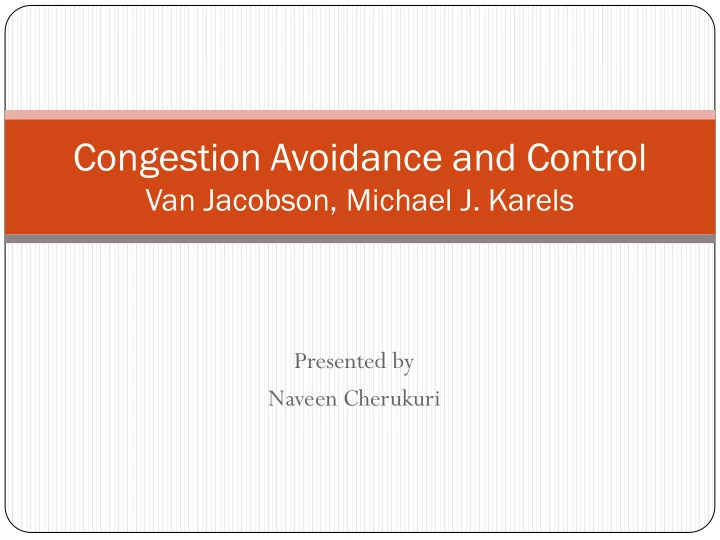

Congestion Avoidance and Control Van Jacobson, Michael J. Karels Presented by Naveen Cherukuri
Overview Introduction Getting to equilibrium Conservation at equilibrium Adapting to the path Experimental evaluation Future work
Introduction Explosive growth of Networks Gateway- Local buffer overflows Cause lies in transport protocol implementation First Congestion collapse observed October 1986, LBL to UCB Data throughput dropped from 32Kbps to 40bps
Packet Conservation Packet Conservation Principle 5 algorithms developed based on this Round-trip-time variance estimation 1. Exponential retransmit timer backoff 2. Slow-start 3. More aggressive receiver ack policy 4. Dynamic window sizing on congestion 5. Connection in equilibrium – Running stably with a full window of data in transit. Conservative packet flow – Flow at equilibrium when “ A new packet isn‟t put into the network until an old packet leaves.
Failures Three ways for “how packet conservation fails” 1)The connection doesn‟t get to equilibrium. 2)A sender injects a new packet before an old packet has exited. 3)The equilibrium can‟t be reached because of resource limits along the path.
Getting to Equilibrium: Slow-start Connection Starting or Restarting Self-Clocking Systems – adjust to bandwidth and delay variations
To get data flowing acks to clock are required and to get acks there must be data flowing Problem – How to start Clock Solution – Slow-start Algorithm to gradually increase the amount of data-in-transit
Slow-start Algorithm Add a congestion window, cwnd , to the per-connection state. When starting or restarting after a loss, set cwnd to one packet. On each ack for new data, increase cwnd by one packet When sending, send minimum of the receiver‟s advertised window and the cwnd .
Analysis Takes Rlog 2 W time to get to equilibrium where R – Round trip time and W – window size in packets. Guarantees that a connection will source data at a rate at most twice the maximum possible on the path.
Conservation at equilibrium: Round-trip timing Failure of sender‟s retransmit timer. A good round trip time estimator – the core of the retransmit timer is the most important feature to survive heavy load. TCP estimates mean round trip time using R = α R + (1- α )M M – round trip time measurement from the most recently acked data packet. α – Filter gain constant with suggested value of 0.9
Retransmit timeout interval(rto) for the next packet sent is set to β R β accounts for RTT variation They argue that β should also be estimated to improve performance at low load as well as high load. Retransmit timer – Exponential back-off
Adapting to the path: congestion avoidance Packets get lost for two reasons They are damaged in-transit 1. Network is congested. 2. Congestion avoidance strategy Network must signal to transport endpoints that congestion is occurring. The endpoints must decrease or increase utilization based on whether the signal is received or not.
Congestion Window adjustment Good candidate for „network is congested‟ signal? Network load is measured by average queue length over fixed intervals of length near the roundtrip time. L i = N ( uncongested network ) L i = N + γ L i-1 ( congested network ) γ indicates the amount of congestion Source controls its loads by adjusting its window. W i = dW i-1 (d < 1) (On congestion)
Congestion Window adjustment Network doesn‟t indicate if a connection is using less than its fair share. Solution? How about W i = bW i-1 1<b<=1/d ?? Rush hour effect Hence W i = W i-1 + u (u << W max ) ( On no congestion)
Congestion Avoidance Algorithm On any timeout, set cwnd to half the current window size (Multiplicative decrease) On each ack for new data, increase cwnd by 1/cwnd (Additive increase) When sending, send the minimum of the receiver‟s advertised window and cwnd.
Experimental evaluation
Future Work : The gateway side of congestion control How to ensure “Fair sharing of the connection‟s capacity”? Solution - Congestion detection algorithm at the gateways. Misbehaving endpoints that do not consider the request to decrease the window size can be taken care of.
Thank you Questions and Suggestions ??
Recommend
More recommend